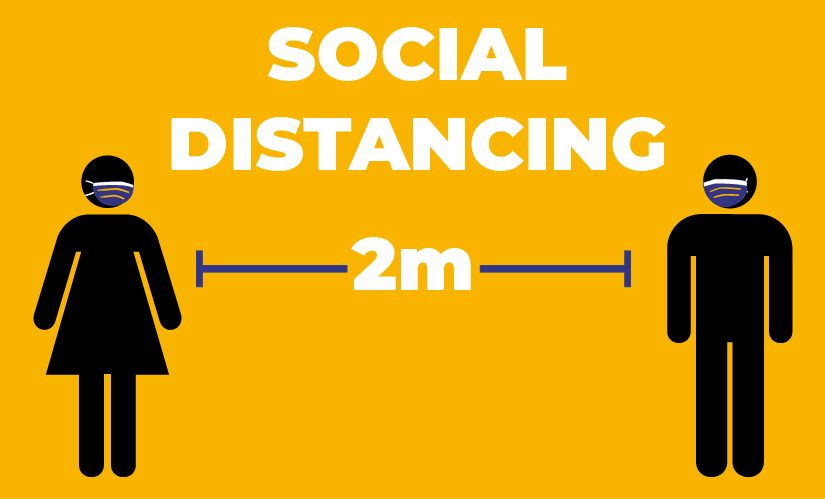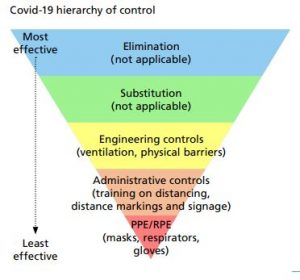
Performing a COVID-19 Risk Assessment
Explore our guide on performing a COVID-19 Risk Assessment in your workplace.
Introduction
This guidance focusses on producing a separate risk assessment for Covid-19. You could also choose to amend existing risk assessments of activities using the information within this guide. A risk assessment covering exposure to COVID-19 will be different in each and every organisation and some sectors will have to plan for higher levels of exposure to the risk.
The purpose of this guide is to pose the questions that need to be asked so that appropriate risk assessments can be created.
Before a risk assessment can be completed, the assessor must first ask; Who is doing what and how, Where they are doing it, Why are they doing it and what they are using. Understanding the activities that are happening within your organisation is vital to assess exposure and to qualify any subsequent control decisions.
Compass HSC is here for all your Health and Safety requirements, this guide offers you a number of questions and considerations which should be considered when performing a COVID-19 risk assessment within your workplace, but if you would prefer to speak to a health and safety professional, call us today on 01253 735 755.
Risk Assessment
Hazard
The risk assessment must recognise the virus as a hazard. It should also reflect that the virus is spread in minute water droplets that are expelled from the body through sneezing, coughing, talking and breathing. The virus can be transferred to the hands and from there to surfaces. It can survive on surfaces for a period after transfer (depending on such things as the surface type, its moisture content and temperature).
The risk assessment should conclude that if it is passed from one person to another, while many survive infection, some may die from the disease. It should be regarded as a high hazard.
Likelihood
You must also consider how exposed people are. Some questions to consider:
- How might your employees meet people with the disease, how frequently and for how long?
- How do your employees travel to work? Does this expose them to public crowds?
- Which employees have vulnerable medical conditions that make them a higher risk and more susceptible to the disease? How can you go about capturing this information?
- Do you know which employees might have increased exposure to the disease due to people in their household?
- When someone within a household must isolate, what will you require them to do?
- Where are employees meeting people who may have the disease, does this place increase exposure (e.g. Confined Spaces vs Outdoors)
Once you can answer these questions, controls to mitigate these risks can be better considered and implemented.
Control
The safety hierarchy of control is a useful tool in considering exactly what can be done to control the risks of COVID-19 in the workplace. Any mitigation controls devised must reduce exposure of employees and anyone who could be infected by your employees. Control considerations must also consider identification of those who have the disease, and what to do if your employee contracts it.

Elimination (Not Applicable)
The best form of control is elimination, but without a vaccine for the disease, there is little that can be done by organisations to eliminate the risk. Social distancing and staying at home are not forms of elimination, but instead an administrative control.
Substitution (Not Applicable)
Replacing the virus for something less harmful is not possible
Engineering Controls
Engineering controls place a physical barrier between the person and the hazard, or providing a mechanical reduction of the hazard. An example of this is the placement of screens, as they interrupt the flow of air from one person to another and therefore provide protection.
Administrative Controls – Adjust Work Practices
Administrative controls provide the best options for most organisations. The risk assessment must consider how you will keep the workplace and equipment clean, adjust your working practices and ensure people are safe.
When designing a safe workplace, questions and considerations should include:
- Can the workplace be redesigned to maintain social distancing?
- Can meeting rooms be re-purposed so as to spread out employees?
- Could you reduce the number of people at the workplace at any one time, reducing space pressure (Proportion of staff continue to work from home)
- Which spots are difficult to avoid one another? This could include security points, lifts, stairs, lobbies, canteens, toilets and hot-desks. What can be done to reduce this pressure, i.e Phased Shift and Break times.
- Can you provide more hand washing or hand sanitising facilities around the workplace?
- Have you noted the spots where people most commonly touch? This typically includes control panels, handles, handrails, kettles and more.
Need some help?
Speak to one of our experts today
Administrative Controls – Cleaning
Cleaning is a vital control and deserves some very careful thought:
- Have you considered how to keep commonly touched surfaces sterile? And how much more frequent they need to be cleaned?
- Are your cleaning materials an appropriate strength to kill the virus?
- Have cleaning checklists been amended to ensure all areas that need frequent cleaning are getting cleaned?
- Have you considered the impact on your cleaners or contract?
- Cleaners are being sent into the places where the virus may have been left. They are exposed to different levels of risk, have you considered how you will protect them?
- Do they have enough cleaning supplies?
- Where and how should they dispose of contaminated cloths?
Considerations about work equipment should include:
- Can the item be allocated to an individual rather than being shared between the team?
- If it must be shared, how will it be cleaned between uses? This includes phones, desks, vehicle cabs, control panels and more.
- If a member of staff falls ill with COVID-19, what deep cleaning procedures will be required to ensure it is safe to use.
- What hand washing / sterilising facilities are available to workers? How often should they wash their hand to reduce the risk of spread on equipment in the environment?
Considerations about safe systems of work should include:
- Can work shifts or patterns be re-ordered to avoid employees being in close proximity with each other? Where this cannot be avoided, can the contact time be reduced?
- When employees must work together, how will you agree COVID-19 control standards? What adjustments to contractor controls might be necessary?
Considerations for ‘safe people’ should include:
- What do your employees need to know about the disease and how they may contract it (for example safe travel to and from work) How will this knowledge be passed on?
- How will you ensure your workers know what COVID-19 controls are required in their work?
- Do employees know how they can reduce the risk of exposure to the virus? What information can be provided?
- What is the process for reporting possible infection or exposure, what do you require of them?
- COVID-19 advice is constantly changing, how will you keep your employees up to date.
- What do your managers need to know to enable them to supervise accordingly?
- Are employees following the rules? If not, why not?
- How can you support workers with special needs
- What provisions do you have in place to support employees through times of increased levels of stress and anxiety during the pandemic? How will you support those who have suffered a personal loss?
Need some help?
Speak to one of our experts today
Personal Protective Equipment (PPE)
PPE is the last resort of the risk control hierarchy. It should be considered as the weakest control because it relies on people using it correctly.
Considerations about PPE include:
- If gloves are provided, the virus can still be transferred to the surface. If a wearer touches their face, they could contract the disease.
- Frequent hand washing and sterilisations is a better option
- Paper face masks could reduce the virus being spread from the wearer to others, but it will do little to protect the wearer.
- The longer it is worn, the greater the risk of its surface containing the virus.
- If not changed regularly, may increase exposure.
- Masks should not be taken off and left lying around, this increases exposure to others who could come into contact with it.
There has been much debate about non-medical usefulness of PPE during the COVID-19 pandemic. It is far better for your organisation to seek to control exposure, rather than to rely on PPE. Prevention is a more effective measure.
All of these questions and considerations relating to the workplace, equipment, safe systems of work and people will lead to the design of good procedures and management systems that will help to reduce exposure to the virus.
Risk Management
Finding answers to the questions that have been discussed in this guide will provide you with a list of possible controls that could be implemented. The risk assessment itself does not control risk or exposure.
Instead, it is the actions of the individuals who apply these controls in order to mitigate the risk. Your risk assessment should results in a risk control action plan, making it very clear as to who needs to do what, and by when.
The successful implementation of this plan must be monitored, and continue to be monitored on an ongoing basis. Plans need to be put in place for routinely reviewing the effectiveness of the control measures identified. Plans must be amended and updated as we learn new information, not only about the virus itself, but also its transmission and control procedures.
Ensure you don’t lose sight of the everyday health and safety risks within your business. It is still your responsibility to maintain effective control of exposure to these risks too.
Example COVID-19 Risk Assessment
Compass HSC has produced an example risk assessment which shows the kind of approach that is expected from workplaces when carrying out a risk assessment for COVID-19 in the workplace.
Use this document as a guide to think about:
- Additional hazards that COVID-19 has introduced into your business
- the steps and measures you will need to take to control the risks.
Please use this document as a guide, don’t simply copy it and put your name to it. This will not satisfy the law, nor would it protect your employees. Each and every business is different and for this reason, your approach to controlling the virus needs to be tailored to your organisation.
Need some help?
Speak to one of our experts today
Book Online
Need some help?
Speak to one of our experts today
Book Online
COVID-19 Employer Guidance
Working Safely Guides
COVID-19 RIDDOR Reporting
PPE in the workplace
Controlling Legionella Risks

Further information
For more specific guidance for your industry or sector visit:
Need some help?
Speak to one of our experts today
Book Online
Contact Compass HSC
A Leading Lancashire based Health & Safety Consultancy

37 Madison Heights,
Coopers Row,
Cypress Point,
Lytham St Annes,
Lancashire
FY8 4UD
